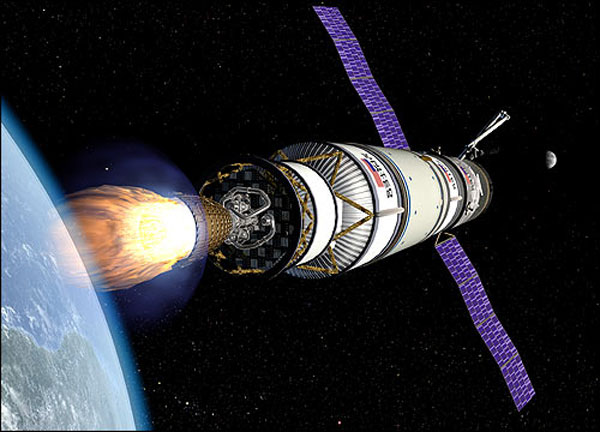Future Moon Missions Will Change NASA Spaceport

CAPE CANAVERAL - U.S.astronauts will launch to the moon on sleek, single, shuttle booster rocketsand the first new upper-stage rocket this country has developed in more than adecade, NASA and the Pentagon have told the White House.
Lunar landers and othergear needed for extended visits to the moon will be lofted by gargantuanlaunchers as big as the
Apollo-era Saturn 5, the most powerful rockets ever flown.
The new moon rockets,cobbled together primarily from proven shuttle components, still will blast offfrom Kennedy Space Center. But the transition from the shuttle to moon missionswill change the face of the Brevard County spaceport.
Landmark facilities such asthe hangars where the orbiters are readied for flight likely will be shutteredas the orbiters retire in 2010. NASA no longer will need the KSC runway forshuttle landings or the factory where workers hand-craft heat-shielding tilesand blankets.
KSC's 14,500-person workforce will shrink by as much as one-third in the next decade. But NASA and itscontractors hope attrition will reduce layoffs. About one-third of shuttleworkers are old enough to retire by 2011.
In speeches this year, KSCdirector Jim Kennedy has speculated KSC employment could drop to as low as10,000, but he would not comment on the employment picture for this article.
"You've got tounderstand that people are nervous. It's always uneasy when the future isuncertain," said John Elbon, vice president and International SpaceStation program manager for The Boeing Co.
Get the Space.com Newsletter
Breaking space news, the latest updates on rocket launches, skywatching events and more!
The angst is deeply rooted,according to worker surveys conducted in February 2004 by shuttle primecontract United Space Alliance, which employs more than 10,000 people combinedat KSC and in Houston.
"The number one issueraised by the work force -- the number
one concern -- was their future, and that was one month after the presidenttalked about the exploration initiative," said USA chief operating officerBrewster Shaw, a former astronaut.
"So it's clearly ontheir minds, and it's been on their minds for a long time."
Shaw, Elbon and others arequick to note that until the January 2004 unveiling of President Bush's plan tosend astronauts back to the moon and beyond, NASA and its contractors had nosure future beyond the shuttle and space station.
NASA's decision to base newmoon rockets on shuttle solid rocket boosters, engines and external tanks andto continue to launch U.S. human space missions here solidifies the future ofKSC and the bulk of the space jobs based here for decades to come.
"There's always asense of anxiety with changes like this," said another ex-astronaut,Charles Precourt, vice president of strategic programs, strategy and businessdevelopment for booster-maker ATK Thiokol.
"But I think there isgoing to be plenty of work to go around."
NASA's rocket decision,expected to be announced next month, is outlined in an Aug. 5 letter to JohnMarburger, director of the White House Office of Science and Technology Policy.
"NASA will initiatedevelopment of a Crew Launch Vehicle derived from space shuttle solid rocketboosters with a new upper stage for human spaceflight," said the letter,signed by NASA Administrator Mike Griffin and the Pentagon's top spaceofficial, ex-astronaut Ron Sega.
The so-called "singlestick" rocket could be ready to launch a proposed Crew Exploration Vehicleby 2011, minimizing the gap in the country's ability to get people into spaceafter the orbiters retire.
Griffin and Sega also saidNASA will field a heavy-lift launcher rivaling Saturn 5 moon rockets in sheerpower and payload capability.
"NASA then plans todevelop a new 100-metric-ton-class launch vehicle derived from existingcapabilities with the space shuttle external tanks and solid rocket boostersfor future missions to the moon," the letter said.
Industry studies indicateits first flight could be as early as 2014.
People and cargo wouldlaunch separately, hook up in Earth orbit, then journey together to the moon.The White House has not given final go-ahead for the two new rockets. Adecision is expected next month.
NASA and its contractorshave spent almost two years studying the pros and cons of various rocket ideas.The two best options: Modify the Delta 4 or Atlas 5 rockets developed for themilitary or use combinations of proven shuttle engines, boosters and fuel tanksto make new launchers.
Study after study came tothe same conclusion: Shuttle-based systems could fly sooner, safer and for lessmoney than the military's rockets.
"I think that's rightif we get started soon. Time's a-wasting," Precourt said. "It appearsthey're getting close to a decision here. It's still reasonable, given that wecould be using components in place today and you could fly a test flight withina couple of years without too much trouble."
NASA and its four biggestshuttle contractors -- USA, Lockheed Martin, Boeing and ATK Thiokol --understand that the new system has to cost far less to operate than theshuttles. A July study by NASA and its contractors says eliminating thehigh-maintenance shuttle orbiters would "reduce operations costs in bothfacilities and work force."
Published under license from FLORIDATODAY. Copyright ? 2005 FLORIDA TODAY. No portion of thismaterial may be reproduced in any way without the written consent of FLORIDA TODAY.
Join our Space Forums to keep talking space on the latest missions, night sky and more! And if you have a news tip, correction or comment, let us know at: community@space.com.
Todd Halvoron is a veteran aerospace journalist based in Titusville, Florida who covered NASA and the U.S. space program for 27 years with Florida Today. His coverage for Florida Today also appeared in USA Today, Space.com and 80 other newspapers across the United States. Todd earned a bachelor's degree in English literature, journalism and fiction from the University of Cincinnati and also served as Florida Today's Kennedy Space Center Bureau Chief during his tenure at Florida Today. Halvorson has been an independent aerospace journalist since 2013.










